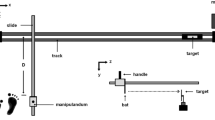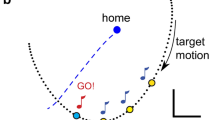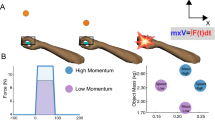Abstract
Do people perform a given motor task differently if it is easy than if it is difficult? To find out, we asked subjects to intercept moving virtual targets by tapping on them with their fingers. We examined how their behaviour depended on the required precision. Everything about the task was the same on all trials except the extent to which the fingertip and target had to overlap for the target to be considered hit. The target disappeared with a sound if it was hit and deflected away from the fingertip if it was missed. In separate sessions, the required precision was varied from being quite lenient about the required overlap to being very demanding. Requiring a higher precision obviously decreased the number of targets that were hit, but it did not reduce the variability in where the subjects tapped with respect to the target. Requiring a higher precision reduced the systematic deviations from landing at the target centre and the lag-one autocorrelation in such deviations, presumably because subjects received information about smaller deviations from hitting the target centre. We found no evidence for lasting effects of training with a certain required precision. All the results can be reproduced with a model in which the precision of individual movements is independent of the required precision, and in which feedback associated with missing the target is used to reduce systematic errors. We conclude that people do not approach this motor task differently when it is easy than when it is difficult.







Similar content being viewed by others
References
Alexander RM (1997) A minimum energy cost hypothesis for human arm trajectories. Biol Cybern 76:97–105
Baddeley RJ, Ingram HA, Miall RC (2003) System identification applied to a visuomotor task: near-optimal human performance in a noisy changing task. J Neurosci 23:3066–3075
Battaglia PW, Schrater PR (2007) Humans trade off viewing time and movement duration to improve visuomotor accuracy in a fast reaching task. J Neurosci 27:6984–6994
Berret B, Darlot C, Jean F, Pozzo T, Papaxanthis C, Gauthier JP (2008) The inactivation principle: mathematical solutions minimizing the absolute work and biological implications for the planning of arm movements. PLoS Comput Biol 4:e1000194
Berret B, Chiovetto E, Nori F, Pozzo T (2011) Evidence for composite cost functions in arm movement planning: an inverse optimal control approach. PLoS Comput Biol 7:e1002183
Brenner E, Smeets JBJ (2005) Intercepting moving targets: why the hand’s path depends on the target’s velocity. In Rogowitz BE, Pappas TN, Daly SJ (eds) Proceedings of SPIE-IS&T electronic imaging on human vision and electronic imaging X, vol 5666. SPIE, pp 374–384
Brenner E, Smeets JBJ (2007) Flexibility in intercepting moving objects. J Vis 7:14
Brenner E, Smeets JBJ (2009) Sources of variability in interceptive movements. Exp Brain Res 195:117–133
Brenner E, Smeets JBJ (2011a) Quickly ‘learning’ to move optimally. Exp Brain Res 213:153–161
Brenner E, Smeets JBJ (2011b) Continuous visual control of interception. Hum Mov Sci 30:475–494
Brenner E, van Dam M, Berkhout S, Smeets JBJ (2012) Timing the moment of impact in fast human movements. Acta Psychol 141:104–111
Brouwer AM, Brenner E, Smeets JBJ (2000) Hitting moving objects. The dependency of hand velocity on the speed of the target. Exp Brain Res 133:242–248
Brouwer AM, Smeets JBJ, Brenner E (2005) Hitting moving targets: effects of target speed and dimensions on movement time. Exp Brain Res 165:28–36
Cheng S, Sabes PN (2007) Calibration of visually guided reaching is driven by error-corrective learning and internal dynamics. J Neurophysiol 97:3057–3069
Churchland MM, Afshar A, Shenoy KV (2006) A central source of movement variability. Neuron 52:1085–1096
de Azevedo Neto RM, Teixeira LA (2011) Intercepting moving targets: does memory from practice in a specific condition of target displacement affect movement timing? Exp Brain Res 211:109–117
de la Malla C, López-Moliner J, Brenner E (2012) Seeing the last part of a hitting movement is enough to adapt to a temporal delay. J Vis 12(10):1–15
Diedrichsen J, White O, Newman D, Lally N (2010) Use-dependent and error-based learning of motor behaviors. J Neurosci 30:5159–5166
Faisal AA, Wolpert DM (2009) Near optimal combination of sensory and motor uncertainty in time during a naturalistic perception-action task. J Neurophysiol 101:1901–1912
Faisal AA, Selen LP, Wolpert DM (2008) Noise in the nervous system. Nat Rev Neurosci 9:292–303
Fitts PM, Peterson JR (1964) Information capacity and discrete motor responses. J Exp Psychol 67:103–112
Gray R (2009) How do batters use visual, auditory, and tactile information about the success of a baseball swing? Res Q Exerc Sport 80:491–501
Harris CM, Wolpert DM (1998) Signal-dependent noise determines motor planning. Nature 394:780–784
Knill DC, Bondada A, Chhabra M (2011) Flexible, task-dependent use of sensory feedback to control hand movements. J Neurosci 31:1219–1237
Marko MK, Haith AM, Harran MD, Shadmehr R (2012) Sensitivity to prediction error in reach adaptation. J Neurophysiol 108:1752–1763
McLeod P, Jenkins S (1991) Timing accuracy and decision time in high-speed ball games. Int J Sport Psychol 22:279–295
Miall RC, Wolpert DM (1996) Forward models for physiological motor control. Neural Netw 9:1265–1279
Nagengast AJ, Braun DA, Wolpert DM (2011) Risk sensitivity in a motor task with speed-accuracy trade-off. J Neurophysiol 105:2668–2674
Narain D, van Beers RJ, Smeets JB, Brenner E (2013) Sensorimotor priors in nonstationary environments. J Neurophysiol 109:1259–1267
Patton JL, Wei YJ, Bajaj P, Scheidt RA (2013) Visuomotor learning enhanced by augmenting instantaneous trajectory error feedback during reaching. PLoS ONE 8:e46466
Salmoni AW, Schmidt RA, Walter CB (1984) Knowledge of results and motor learning: a review and critical reappraisal. Psychol Bull 95:355–386
Schmidt RA, Zelaznik H, Hawkins B, Frank JS, Quinn JT Jr (1979) Motor-output variability: a theory for the accuracy of rapid motor acts. Psychol Rev 86:415–451
Shmuelof L, Huang VS, Haith AM, Delnicki RJ, Mazzoni P, Krakauer JW (2012) Overcoming motor “forgetting” through reinforcement of learned actions. J Neurosci 32:14617–14621
Todorov E, Jordan MI (2002) Optimal feedback control as a theory of motor coordination. Nat Neurosci 5:1226–1235
Tresilian JR, Plooy A (2006) Systematic changes in the duration and precision of interception in response to variation of amplitude and effector size. Exp Brain Res 171:421–435
Tresilian R, Oliver J, Carroll J (2003) Temporal precision of interceptive action: differential effects of target size and speed. Exp Brain Res 148:425–438
Trommershäuser J, Gepshtein S, Maloney LT, Landy MS, Banks MS (2005) Optimal compensation for changes in task-relevant movement variability. J Neurosci 25:7169–7178
Trommershäuser J, Landy MS, Maloney LT (2006) Humans rapidly estimate expected gain in movement planning. Psychol Sci 17:981–988
Trommershäuser J, Maloney LT, Landy MS (2008) Decision making, movement planning and statistical decision theory. Trends Cogn Sci 12:291–297
van Beers RJ (2009) Motor learning is optimally tuned to the properties of motor noise. Neuron 63:406–417
van Beers RJ (2012) How does our motor system determine its learning rate? PLoS ONE 7(11):e49373
van Beers RJ, Brenner E, Smeets JBJ (2013) Random walk of motor planning in task-irrelevant dimensions. J Neurophysiol 109:969–977
Wei K, Körding K (2009) Relevance of error: what drives motor adaptation? J Neurophysiol 101:655–664
Wei K, Körding K (2010) Uncertainty of feedback and state estimation determines the speed of motor adaptation. Front Comput Neurosci 4:11
Acknowledgments
We wish to thank Jenny Edner for collecting the data.
Author information
Authors and Affiliations
Corresponding author
Rights and permissions
About this article
Cite this article
Brenner, E., Cañal-Bruland, R. & van Beers, R.J. How the required precision influences the way we intercept a moving object. Exp Brain Res 230, 207–218 (2013). https://doi.org/10.1007/s00221-013-3645-7
Received:
Accepted:
Published:
Issue Date:
DOI: https://doi.org/10.1007/s00221-013-3645-7




